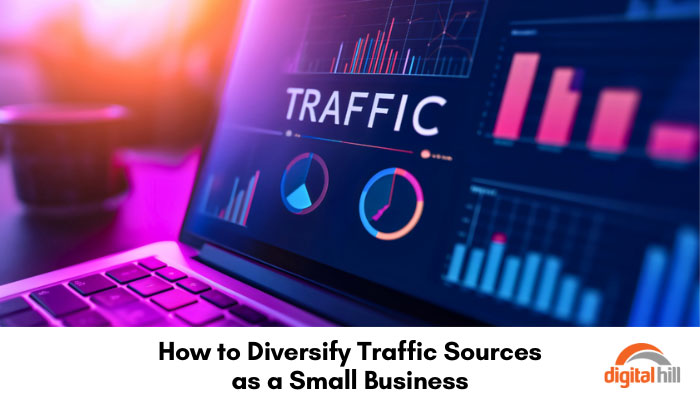How to Diversify Traffic Sources as a Small Business

As a small business owner, relying solely on a single traffic source can be risky. Changes in algorithms, policy shifts, or unexpected downtimes can all significantly impact your business. Diversifying your traffic sources is essential to ensure stability and continued growth. This article explores effective strategies on how to diversify traffic sources for your small business.
Understanding the Importance of Diversification
Relying on one traffic source is like putting all your eggs in one basket. If something goes wrong, you could face a significant drop in visitors and potential customers. Diversifying your traffic sources can help mitigate these risks, providing a more stable and resilient foundation for your business. The main benefits include:
- Stability: Reduces the impact of changes or disruptions in one platform.
- Reach: Expands your audience by tapping into different channels.
- Growth: Increases opportunities for new leads and customers.
Leveraging Social Media
Social media platforms offer an excellent opportunity to reach a large audience. By maintaining an active presence on multiple platforms, you can engage with your audience in various ways. Use the strategies below to improve your social media presence and generate traffic.
- Be Consistent: Regularly update your profiles with engaging content.
- Engage with Followers: Respond to comments, messages, and mentions to build a loyal community.
- Utilize Ads: Invest in targeted social media ads to reach potential customers.
Platforms to Use
- Facebook: Great for community building and sharing updates.
- Instagram: Ideal for visual content and connecting with younger audiences.
- LinkedIn: Perfect for B2B marketing and professional networking.
Email Marketing
Email marketing remains one of the most effective ways to communicate directly with your audience, even in the age of social media. Building an email list allows you to send personalized messages and promotions to your subscribers. Set up a pop-up on your website, and invite audience members to sign up using social media. A successful email marketing campaign requires:
- Valuable Content: Offer insights, tips, and exclusive deals to keep your subscribers engaged.
- Segmentation of Your Audience: Tailor your messages using subscriber preferences and behaviors.
- Monitoring of Performance: Track open rates, click-through rates, and conversions to optimize your campaigns.
SEO and Content Marketing
Search engine optimization (SEO) and content marketing are long-term strategies that can drive organic traffic to your website. By creating high-quality content that resonates with your audience, you can improve your search engine rankings and attract more visitors. Successful SEO requires the following:
- Keyword Research: Identify relevant keywords and incorporate them into your content.
- Quality Content: Publish well-researched, informative, and engaging articles.
- Backlink Building: Earn backlinks from reputable websites to boost your site’s authority.
Content Ideas:
- Blog Posts: Share industry insights, how-to guides, and case studies.
- Videos: Create tutorials, product demonstrations, and customer testimonials.
- Infographics: Visual content that simplifies complex information.
Utilizing Online Communities
Participating in online communities and forums that relate to your industry can help you reach a highly targeted audience. By providing valuable input and establishing yourself as an authority, you can attract visitors to your website. For successful engagement online, you’ll need to:
- Find Relevant Forums: Search for forums and groups where your target audience gathers.
- Be Active: Regularly participate in discussions and answer questions.
- Share Your Expertise: Provide helpful advice and links to relevant content on your website.
Paid Advertising
While organic methods are crucial, paid advertising can provide an immediate boost in traffic. Google Ads and social media ads allow you to target specific demographics and interests across the web. Be sure to follow these best practices to get better results:
- Set Clear Goals: Define what you want to achieve with your ads, such as increasing website traffic or generating leads.
- Targeting: Use demographic and interest-based targeting to reach the right audience.
- Monitor and Adjust: You should continuously track the performance of your ads and make necessary adjustments to improve performance.
Collaborating with Influencers
Partnering with influencers in your industry or adjacent industries can help you reach a broader audience. Influencers have established credibility and a loyal following, making them an effective channel for promoting your business. Follow the steps below to get started:
- Identify Relevant Influencers: Look for influencers who align with your brand values and have a significant following in your niche.
- Propose Collaborations: Reach out with a clear proposal outlining the benefits of collaboration.
- Track Results: Measure the impact of the influencer campaigns on your traffic and sales.
A Holistic Approach to Traffic Diversification
Diversifying your traffic sources involves a combination of strategies tailored to your business needs. By leveraging social media, email marketing, SEO, online communities, paid advertising, and influencer collaborations, you can create a robust and resilient traffic generation system.
Taking a proactive approach to traffic diversification can help safeguard your business against unforeseen disruptions and pave the way for sustained growth and success.
